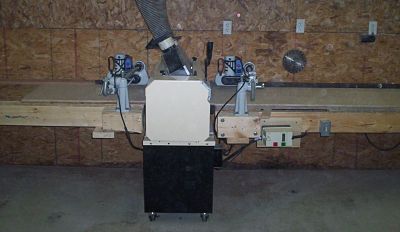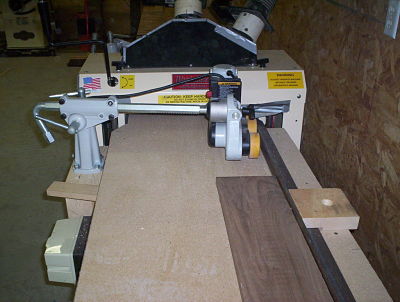Question
I run a custom stair company and am looking to upgrade to a planer that can handle 20"+ wide material. Woodmaster has a 25" planer/gang rip/molder that isn't much more than a wide planer in itself. It would be great to be able to gang rip blanks for glue-ups, plane them down, and even make some of the moldings I normally outsource. Am I being naive to think a machine will actually do all these functions efficiently? Is the planer portion alone worth the investment? Am I better off looking for separate machines for the different functions?
Forum Responses
(Solid Wood Machining Forum)
From contributor D:
I bought a 718 and set it up permanently as a straightedge/gangrip saw. We have never used it for anything else. I ordered it with a 10 hp 3 phase drive motor, the 1/2 hp, 23 fpm feed motor and serrated steel feed rollers. I changed the feed pulleys when we were setting it up so it will feed at 46 fpm. You can feed a rough, unstraightened board in and get straight blanks out. It took a couple days to set it up. It won't do it right out of the box. As far as changing from one process to another, I think it wastes too much time. I always thought doing that was for hobbyists that aren't trying to make money. I do think Woodmaster is a good machine, and if I could do it over, I would have got the 725.
My machine turns out real nice molding and T&G products. I also cut curved moldings after first cutting out the blanks on the CNC, very fast. I have quite a library of molding knives now, but nobody ever seems to need the same knife.
I have another buddy that has the 725 and have not heard him complain. The Woodmaster is not the "heavy steel" type of machine, but mine has seemed to hold together pretty good under hard use for 3 years. I am still leery of Chinese machines, although I must admit to not owning any to give them a fair trial.
The service is pretty good. When I call to order blades, sandpaper or other stuff, I get to talk to the same guys that would sell a machine, and they are pretty informed and take the order and get the stuff out quick (they must be on commission!) So overall I would say they are a pretty good outfit to deal with. I would buy another one if I got the chance.
This picture shows the Woodmaster and feeders. A long pallet with upright stakes fastened to each corner goes under the outfeed table and the usable offcuts get thrown in it. When it's full you take them out with the forklift. The scrap strips fall on the floor on the back side. If you look close you will see there is only one leg at the back of each table so you don't have to work around a front leg. The tables are also fastened with a board running across the end extending to the wall and are really stable.
I had bought the feeders to use on a homemade moulding machine I had built. I bought my Logosol moulder, dismantled the homemade machine, and then had the idea to get the Woodmaster and set it up like it is now using the feeders I already had.

Here is one more picture. This was taken on the infeed side. The fence on the right is a 12' long piece of angle iron. It will adjust about an inch more to the right for badly bowed boards. To adjust the fence we slide the wooden handle, seen beside the feeder base in the picture. The handle slides about 1 1/2' to move the fence 1".
The small feeders on each side of the saw are what keeps the lumber against the fences. The Woodmaster itself does not have a way of keeping things straight. I realize I missed your question about glue line edges. As already noted, the Woodmaster will not make glue edges. I agree that it is not a big, heavy machine, but it is a simple design and holds up well with use.
